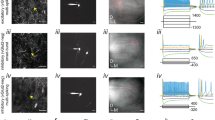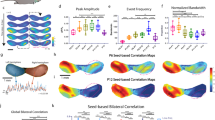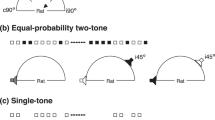Abstract
Neurons in the lateral superior olive (LSO) compute sound location based on differences in interaural intensity, coded in ascending signals from the two cochleas. Unilateral destruction of the neuronal feedback from the LSO to the cochlea, the lateral olivocochlear efferents, disrupted the normal interaural correlation in response amplitudes to sounds of equal intensity. Thus, lateral olivocochlear feedback maintains the binaural balance in neural excitability required for accurate localization of sounds in space.
This is a preview of subscription content, access via your institution
Access options
Subscribe to this journal
Receive 12 print issues and online access
$209.00 per year
only $17.42 per issue
Buy this article
- Purchase on Springer Link
- Instant access to full article PDF
Prices may be subject to local taxes which are calculated during checkout


Similar content being viewed by others
References
Guinan, J.J. The physiology of olivocochlear efferents. in The Springer Verlag Handbook of Auditory Research: The Cochlea, Vol. VIII (eds. Dallos, P.J., Popper, A.N. & Fay, R.R.) (Springer Verlag, New York, 1996).
Groff, J.A. & Liberman, M.C. J. Neurophysiol. 90, 3178–3200 (2003).
Le Prell, C.G., Shore, S.E., Hughes, L.F. & Bledsoe, S.C., Jr. J. Assoc. Res. Otolaryngol. 4, 276–290 (2003).
Mills, D.M. J. Acoust. Soc. Am. 113, 914–924 (2003).
Melcher, J.R. et al. Hear. Res. 93, 1–27 (1996).
Brown, M.C. J. Comp. Neurol. 337, 600–613 (1993).
Lu, S.M., Schweitzer, L., Cant, N.B. & Dawbarn, D. Hear. Res. 31, 137–146 (1987).
Warr, W.B., Boche, J.B. & Neely, S.T. Hear. Res. 108, 89–111 (1997).
Schofield, B.R. J. Comp. Neurol. 344, 83–100 (1994).
Ehret, G. & Dreyer, A. J. Exp. Biol. 109, 163–174 (1984).
Chen, Q.C., Cain, D. & Jen, P.H. J. Exp. Biol. 198, 2007–2023 (1995).
Taberner, A.M. & Liberman, M.C. J. Neurophysiol. 93, 557–569 (2005).
Scharf, B., Magnan, J., Collet, L., Ulmer, E. & Chays, A. Hear. Res. 75, 11–26 (1994).
May, B.J., Budelis, J. & Niparko, J.K. Arch. Otolaryngol. Head Neck Surg. 130, 660–664 (2004).
Acknowledgements
Research supported by grants from the National Institute on Deafness and other Communicative Disorders: RO1 DC0188, P30 DC5209 and T32 DC0038
Author information
Authors and Affiliations
Corresponding author
Ethics declarations
Competing interests
The authors declare no competing financial interests.
Supplementary information
Supplementary Fig. 1
Unilateral LOC destruction caused interaural amplitude disparities corresponding to a constant percentage change at the higher stimulus levels. (PDF 549 kb)
Rights and permissions
About this article
Cite this article
Darrow, K., Maison, S. & Liberman, M. Cochlear efferent feedback balances interaural sensitivity. Nat Neurosci 9, 1474–1476 (2006). https://doi.org/10.1038/nn1807
Received:
Accepted:
Published:
Issue Date:
DOI: https://doi.org/10.1038/nn1807
This article is cited by
-
Type II spiral ganglion afferent neurons drive medial olivocochlear reflex suppression of the cochlear amplifier
Nature Communications (2015)
-
Cochlear efferents in developing adult and pathological conditions
Cell and Tissue Research (2015)
-
The Olivocochlear Reflex Strength and Cochlear Sensitivity are Independently Modulated by Auditory Cortex Microstimulation
Journal of the Association for Research in Otolaryngology (2015)
-
Voltage-gated K+ channels contributing to temporal precision at the inner hair cell-auditory afferent nerve fiber synapses in the mammalian cochlea
Archives of Pharmacal Research (2014)
-
Identification of Inputs to Olivocochlear Neurons Using Transneuronal Labeling with Pseudorabies Virus (PRV)
Journal of the Association for Research in Otolaryngology (2013)



